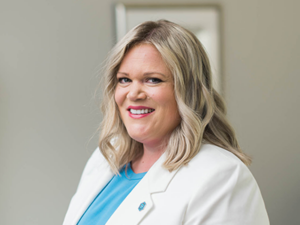When you ask Ashley Podhradsky to explain a cybersecurity concept or the current threat landscape, she offers you a cheerful warning: “I could spend all day on this.”
What she manages to pack into the next five minutes of conversation is a crash course in social engineering, the techniques bad actors use to manipulate a target into revealing security credentials or other privileged information. It’s also an eloquent example of her ability to balance her deep knowledge with explanations that make sense to the layperson.

Any bank would be lucky to have a director like Podhradsky, who brings a Doctor of Science degree in Information Assurance. Fortunately for Brookings, S.D.-based First Bank & Trust, she works at nearby Dakota State University in Madison, S.D., where she’s vice president for research & economic development.
For contributions to First Bank, particularly in the realm of cybersecurity, Podhradsky has been named a 2024 “Amazing Outside Director” by BankBeat magazine.
“She brings a lot of awareness to the board about what’s coming down the pipe,” said Chris Kreul, chief technology officer at the $4.5 billion First Bank. “She always asks intriguing questions and lets us know what she’s seeing at the university level in the different programs she’s involved with.”
Podhradsky checked a couple boxes when she joined the board: She was based in Madison, where one of First Bank’s predecessor charters was based and where the bank still has a significant presence. Her cybersecurity background impressed chair Van Fishback, who’s also part of the ownership group. Podhradsky gave several presentations to the board on cybersecurity, which quickly led to a seat at the table.
“It is rare to find a board member with that level of technical knowledge,” said Kristina Schaefer, the bank’s chief risk officer and chief administrative officer, who also works closely with the institution’s directors.
Schaefer and Kreul both praised Podhradsky’s ability to quickly and clearly relate complex information and concepts to those without a tech background. Kreul highlighted Podhradsky’s work with social engineering, which has helped improve First Bank’s management of its employees’ security behavior.
“Good hackers, they don’t hack in — they log in,” Podhradsky said. It’s far easier for bad actors to gain access by stealing credentials or tricking employees into letting them in. “They just have to get you to give it to them, and it’s really not that challenging” she said. “One of the most important preventative things that you can do is you can treat every piece of communication like it’s a phishing piece of communication.”
Another arena in which Podhradsky helps bolster First Bank’s security is in external audits. Before she joined the board, some of the cybersecurity audits were disjointed, Kreul said, with useful information sitting in different analyses and no one comparing different results to get a big picture view. “She pushed to have the tests integrated,” he said. “If there’s a failure in social engineering, let’s use that failure to explore why it happened. How can we learn from this and improve our cybersecurity posture?”
At Dakota State, Podhradsky works with a digital forensics lab which investigates those kinds of social engineering attacks. Before teaching, she also spent a decade working on digital forensic investigations for financial institutions through a separate organization. She brings the knowledge gleaned at the lab back to the bank.
First Bank’s involvement with DSU goes beyond Podhradsky’s presence on the board. It’s frequently hired graduates from the school, particularly for IT roles, and it’s been fruitful for both sides.
“She very much cares about doing the right thing and is always very helpful,” Kreul said. “She wants to prepare the next generation for what the future holds.”
Part of that work preparing the next generation of cybersecurity workers has been the CybHER Security Institute, which Podhradsky founded in 2013. The nonprofit is dedicated to educating and raising awareness of girls and women in cybersecurity from middle school to college and beyond into professional careers. Podhradsky wanted to help offer girls and young women the kind of mentorship and support she didn’t always have when she was growing up.
First Bank has supported Dakota State with donations, including for the CybHER initiative.
“Any time you have a board member with a unique skillset who’s very involved in the community, that’s a great opportunity to make sure you’re serving your community well, too,” Schaefer said.
The partnership between the two institutions is also useful because it helps model the different kinds of work possible at banks. “There can be some stereotypes about what a banker looks like,” Schaefer said. “It can be hard to show people that it’s not just loan officers who work in a bank but that we need skilled IT workers, today more than ever. This helps with that.”
For Podhradsky, her work with First Bank has also been a way to ensure the strength of South Dakota’s communities.
“I don’t want to say that I’m a cynic, but you wouldn’t think that most organizations could emulate that behavior all the time. And they really do,” she said. “They really do value and appreciate and have mutual respect for all the players within the organization.”
